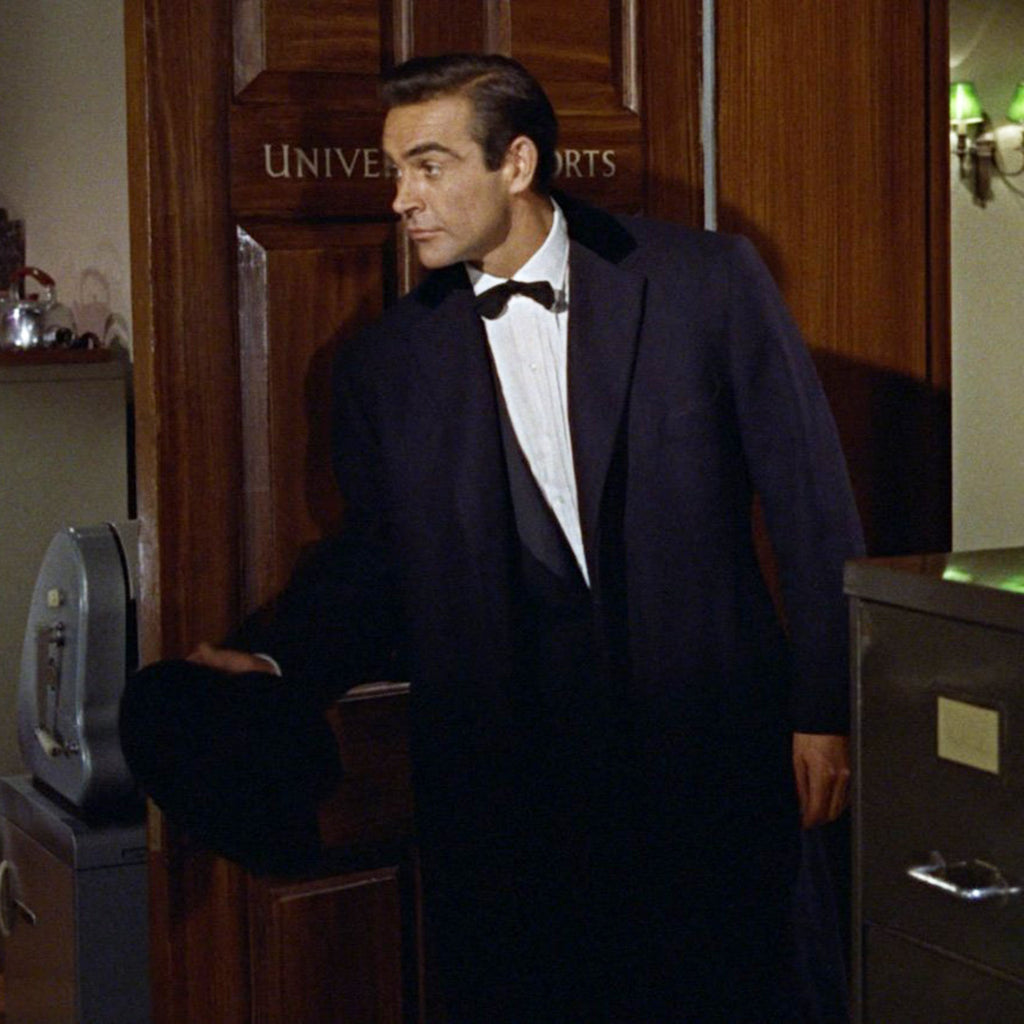The Hottest Coat is a Cool Chesterfield
One of the few surviving items from Sean Connery's 007 wardrobe, that remains in the EON archives, is a Navy Chesterfield Overcoat made by Anthony Sinclair in 1962 for the first James Bond movie, Dr. No.

Connery keeping cool in Anthony Sinclair tailoring. Dr No (1962)
The coat was worn over the iconic Midnight Blue Dinner Suit, as 007 reports to M in one of the earliest scenes of the film. The Chesterfield and the tuxedo remain, to this day, essential elements of Bond’s kit, and indeed that of every jet-setting gentleman’s wardrobe.

Sean Connery and Daniela Bianchi boarding a flight to Istanbul (1963)
The garment in question first appeared in the mid 19th Century and was distinct from other coats of the time (such as frock coats) in that it dispensed with the horizontal waist seam designed to fit clothes closely to the body. The style was adopted by the 7th Earl of Chesterfield (below), from whom the design takes its name, and the coat was worn comfortably over other articles of clothing – such as the lounge suit that became popular during the late 1800s.

George Stanhope, 7th Earl of Chesterfield (c.1860)
Many consider the classic styling of a Chesterfield to be single-breasted with a 3-button fly-front, centre vent and flaps on the side pockets, cut from a dark navy or charcoal cloth with a velvet collar. However, the coat can also be made in lighter colours, without velvet trim and cut in a double-breasted style… or even single-breasted with peak lapels.

Sinclair fitting Connery for a Chesterfield coat (1963)
One consistency across all Chesterfield designs is a pair of sleeves. However, if your super-hero style is more caped-crusader than secret-agent they are not always necessary, but please be warned, the over-the-shoulder look could make you the subject of ridicule amongst your peers.

Sean Connery, Phyllis Newman, and Leonard Bernstein at the New York premiere of 'Dr No' (1963)
In the first half of the 20th Century, tailors were cutting all manner of Chesterfield coat styles for their customers. By the 1960s, ready-to-wear tailoring had gained in popularity to the point where those who had not planned their winter wardrobe in advance could pick up a coat “off the peg/rack” for immediate use in case of a sudden cold snap.

Ready-to-wear Chesterfields, Raglans and Car Coats at Simpsons (c.1955)
Some notable bespoke tailors entered this market – including Anthony Sinclair. Following the success of the ultra stylish Bond film, Goldfinger (1964), the word had got out that Sinclair was James Bond’s tailor. He signed a deal with Sir Montague Burton to design a range of clothing that would be manufactured under license by the Burton’s menswear group. Naturally, this included a Chesterfield coat – a vintage example of which can be seen below. It is made from a herringbone tweed and features special 007 labels and signature quilted lining which adds warmth, softness and a luxurious touch.

Ready-to-wear Chesterfield styled by Anthony Sinclair for Burtons (1964)
For the 1965 Bond film, 'Thunderball', Anthony Sinclair crafted another classic piece of outerwear for Sean Connery. The Grey Herringbone Topcoat was less formal than the navy Chesterfield from 'Dr No'. It was produced in a textured cloth, devoid of velvet collar, and slightly shorter in length. It was paired with a relatively relaxed outfit of blazer and flannels, and deemed light and comfortable enough for Bond to wear whilst driving his Aston Martin, at speed, to escape an assassination attempt.

In 1973, Sean Connery’s licence to kill was surrendered to Roger Moore, and the tailor’s shears were passed from Anthony Sinclair to his close friend and Conduit Street neighbour Cyril Castle who had made Moore’s clothes for the wildly popular television series, The Saint.

Cyril Castle fitting Roger Moore in bespoke finery
For Sir Roger’s debut in Live and Let Die, Castle produced one of the finest pieces of clothing ever to grace the frame of a Bond character. Moore’s double-breasted Chesterfield coat was crafted to perfection, immediately prompting his friends, Frank Sinatra and Sammy Davis Jnr., to demand the name of its creator… both gentlemen going on to become lifelong customers of the legendary tailor.

The double-breasted Chesterfield. 'Live And Let Die' (1973)
The subsequent designer decades witnessed a shift away from traditional tailoring, and Bond’s image moved with the times. It wasn’t until Daniel Craig’s incarnation of the character appeared that 007 returned to formality. Craig’s shawl-collar dinner jacket, pared-down suits, plain shirts and ties, and neatly folded linen pocket squares echoed Connery’s style from the sixties… and the one item of clothing that topped the lot was, of course, the Chesterfield coat.

Back to formality. Daniel Craig. 'Spectre' (2012)
Photo: WENN Rights Ltd / Alamy
